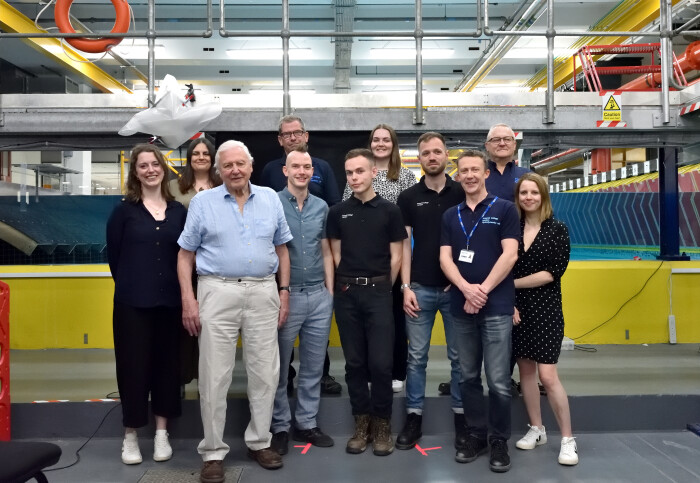
The Imperial team behind the scenes with Sir David Attenborough. Photo credit: Jo Mieszkowski

Imperial’s part in the documentary Attenborough and the Giant Sea Monster is the end result of collaboration and teamwork from Imperial.
Attenborough and the Giant Sea Monster, which aired on New Year’s Day, featured Imperial’s Dr Luke Muscutt, who was interviewed by Sir David Attenborough while testing out his robotic plesiosaur named Flip. Read more about Dr Muscutt’s involvement in the programme and bringing the robot to life.
Part of the documentary was filmed right here on our South Kensington Campus in our Hydrodynamics lab where the robot plesiosaur was captured in action.
Watching Imperial’s part in the documentary from the comfort of your sofa on New Year’s Day is the end result of collaboration and teamwork from colleagues across Imperial. We spoke to those behind the scenes about their involvement.
Caroline Brogan, Media Manager (Engineering), coordinated with the BBC and Dr Muscutt. The team behind the Hydrodynamics Lab, David De Ruyter, Lab Manager, and Ioannis Karmpadakis, Lecturer in Coastal Engineering, were key to realising the vision of the robot in the water while keeping everyone’s safety in mind. With vast experience of VIP visits to campus, Stelios Philippou, Security Services Manager, ensured that the filming ran smoothly.
Caroline Brogan - Media Manager (Engineering), Communications Division
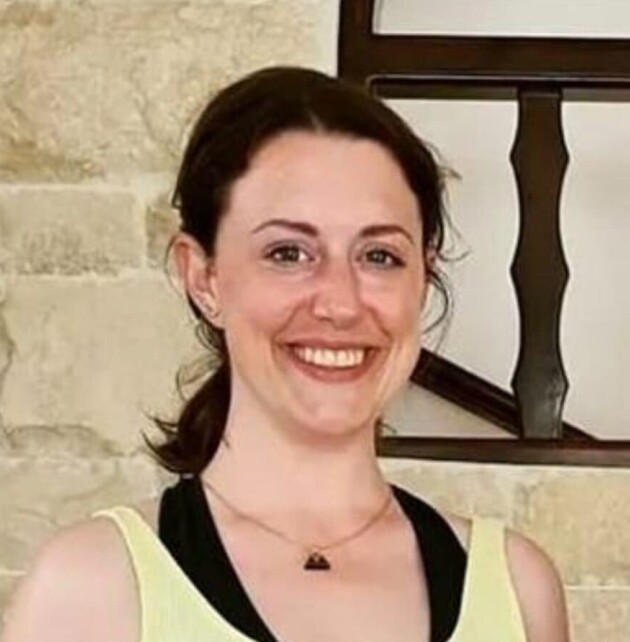 It all started when Luke got in touch with the Press Office with the news that the BBC were coming to film his robot. We were told that Sir David Attenborough would be presenting – he is such a giant in the natural history space and an inspiration for science communicators like me. I grew up watching him on TV.
It all started when Luke got in touch with the Press Office with the news that the BBC were coming to film his robot. We were told that Sir David Attenborough would be presenting – he is such a giant in the natural history space and an inspiration for science communicators like me. I grew up watching him on TV.
I got in touch with the BBC to pin down a filming day and the finer details about exactly what they wanted to see, which turned out to be the plesiosaur robot taking a swim! Luke had made arrangements to have it filmed in our Hydrodynamics Lab, which is a huge, 3,000 square metre space with two of the largest water tanks in the UK and six flumes, and which is used to test the dynamics of waves. By recreating ocean conditions, like during storms, it can help our researchers look at things like coastal erosion and shipping conditions. Best of all, the tanks have clear sides, which make for a great filming location to showcase a swimming prehistoric sea monster.
It's always really important to be collaborative when you're dealing with media requests. Filming and press work requires the buy-in, time and effort from so many different parties across Imperial. Caroline Brogan Media Manager (Engineering)
It's always really important to be collaborative when you're dealing with media requests. Filming and press work requires the buy-in, time and effort from so many different parties across Imperial, from the Community Safety and Support Team, to the technicians with the expertise to run the lab, to colleagues in the Communications Division. I particularly enjoy learning about our academics’ work and ensuring they feel supported.
As a team we handle filming very regularly. We're a top university and very innovative so that makes really good stories for the media. I don't think people realise until you do this kind of work that depending on how big the filming is, it can take months to prepare for. We need to make sure permissions are secured, that our academics are prepared, and that we are represented properly as Imperial College London with our branding on point.
Filming is often quite intense and there can be a lot of spontaneity from the creative team, so resourcefulness and an open mind is key.
I feel it’s important that academics have a good experience when communicating their work and that they feel supported. Achieving media coverage for research can lead to so many opportunities like industrial collaborations, funding and PhD applications.
But for me the best thing is when you see the result when you’re at home watching it on TV and you just think, wow, I was part of that.
I've worked at Imperial for eight years. I really like promoting and communicating about science. My day-to-day life includes speaking to academics about their work and speaking to journalists about what they're looking for. I write also news stories, press releases and features, record podcasts, assist with in-house and media filming, communicate research on our website, and pitch Imperial’s groundbreaking research to the media.
David De Ruyter - Lab Manager, Civil and Environmental Engineering
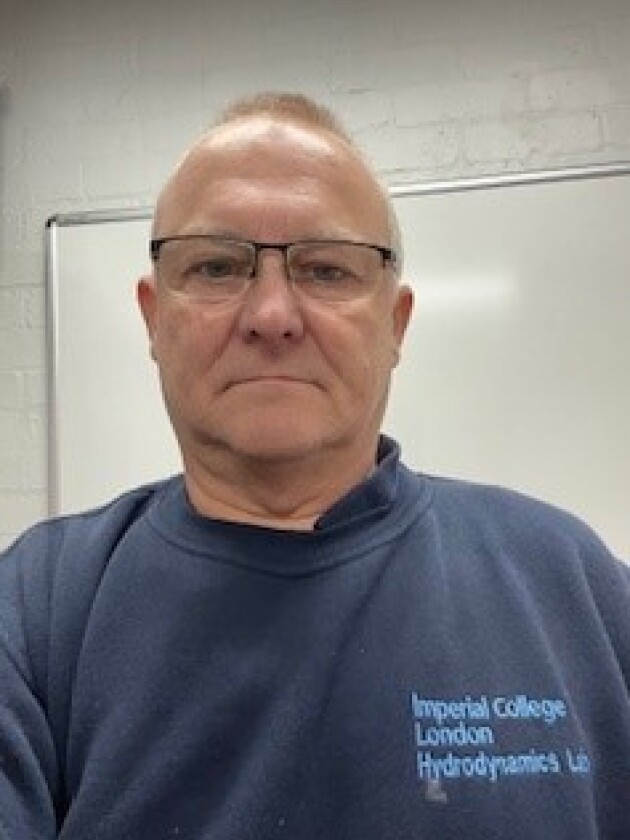 It was an entertaining day, I must say. I think the hard part to start off with was keeping it quiet!
It was an entertaining day, I must say. I think the hard part to start off with was keeping it quiet!
I met with Luke prior to the filming when he showed me the model and what he’d like to do with it. We had to work out how to get it to move from one side of the tank to the other and worked on building and testing solutions. It actually worked out extremely well and hopefully that shows in the programme.
Caroline came to visit beforehand to talk about logistics and what was going to happen. The film crew also came in advance to scope out the lab.
I made sure everyone involved had a lab induction. Health and safety was important, especially as the filming was taking place inside and around the wave tank, with people getting in and out of the water.
The film crew were fantastic. They made it very clear and simple to understand what they wanted and how they wanted to do things. It was impressive to see the camera and light set up, and to be able to help out with the logistics of filming in the water. I also made sure the water was lovely and crystal clear to get the best shots!
If you’ve ever been to the Hydrodynamics lab, you’ll know the size of the space and the toys we’ve got in there. When we were walking through, Sir David was asking more questions about what we do and the kit we have, and wanted to learn more. David De Ruyter Lab Manager
It was fantastic to have Sir David in the lab. What can you say about meeting a national treasure that you’ve spent the last 40 - 50 years watching. If you’ve ever been to the Hydrodynamics lab, you’ll know the size of the space and the toys we’ve got in there. When we were walking through, Sir David was asking more questions about what we do and the kit we have, and wanted to learn more.
I come from an aeronautical engineering background and have been working at Imperial since 2007. I'm lucky enough to manage what I think is the biggest lab at Imperial. Students come to us with their ideas and initial designs, and we advise and help make them work. It can often be a big learning curve for students, designing for use in water. I’m still learning myself – it’s enjoyable to work on project after project that is different. Once we get projects working and the student is happy, we’re happy! That’s really rewarding.
Ioannis Karmpadakis - Lecturer in Coastal Engineering, Civil and Environmental Engineering
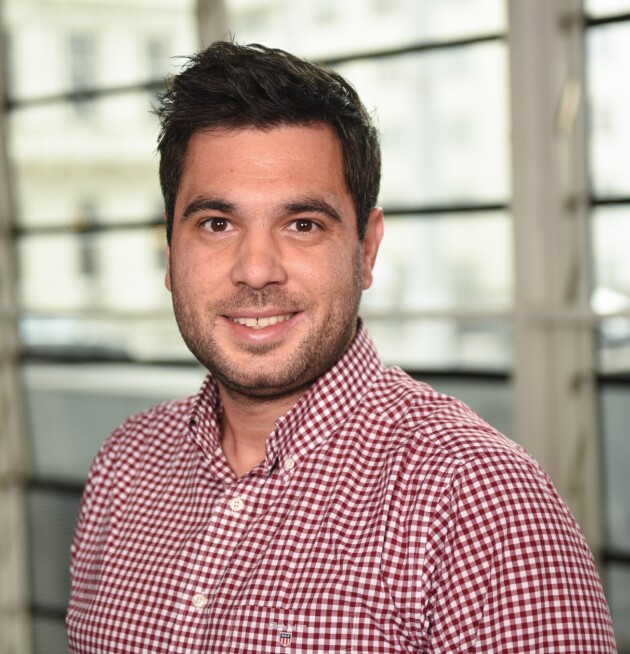 I am a lecturer in Coastal Engineering and the Director of the Hydrodynamics Laboratory at the Department of Civil and Environmental Engineering. Our deep-water wave basin was used for filming Luke’s project. At the moment, we are using a different wave flume to conduct follow-on research on the hydrodynamics of a marine reptile and other bio-mimetic robots.
I am a lecturer in Coastal Engineering and the Director of the Hydrodynamics Laboratory at the Department of Civil and Environmental Engineering. Our deep-water wave basin was used for filming Luke’s project. At the moment, we are using a different wave flume to conduct follow-on research on the hydrodynamics of a marine reptile and other bio-mimetic robots.
The filming required a lot of coordination between teams. We needed to think of everything that could go wrong and make sure it didn’t happen. The primary concern is always health and safety, especially within a working lab. We also had to get all the filming equipment into the lab safely. We're talking about several trolleys of equipment – very expensive lights and cameras.
The hydrodynamics laboratory contains a unique collection of eight world-leading wave tanks of different sizes and different capabilities. Ioannis Karmpadakis Lecturer in Coastal Engineering
The hydrodynamics laboratory contains a unique collection of eight world-leading wave tanks of different sizes and different capabilities. Our research has partly been focused on pioneering the technology and the methods to generate waves accurately, to incorporate challenging aspects like the randomness of waves, how big they are, and how to generate extreme waves in a laboratory environment.
What makes our facilities so unique is the high level of accuracy in wave generation and that they complement each other. This allows us to isolate effects at different scales, and then we can use them complementarily to address problems that are by nature very complex to understand. We also have facilities that can add wind and currents on top of waves as well as change the bathymetry to address both coastal and offshore challenges.
In my research I'm really interested in extreme waves, their properties and how these drive our decisions on the design of coastal and offshore structures and marine renewables. I am also looking at how storm severity and climate change affect key challenges of our time in the coastal region, such as coastal flooding and erosion.
Stelios Philippou - Security Services Manager, Community Safety and Support
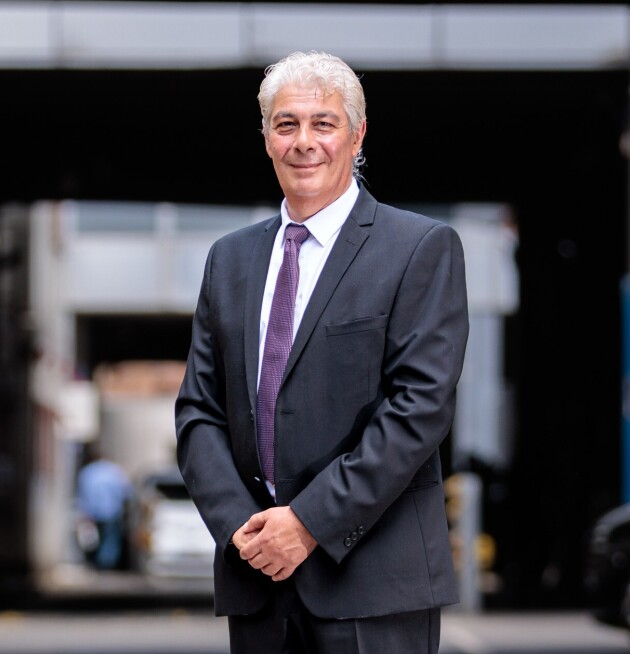 Our role in Community Safety and Support is to make sure our campuses run smoothly and that our community and guests are supported. When we are visited by guests who might attract attention, it helps for us to be part of the planning process, do a walk-through of the route that will be taken, arrange for access to buildings, and to be aware of the schedule. We’re present and there if we’re needed on the day but keep out of sight.
Our role in Community Safety and Support is to make sure our campuses run smoothly and that our community and guests are supported. When we are visited by guests who might attract attention, it helps for us to be part of the planning process, do a walk-through of the route that will be taken, arrange for access to buildings, and to be aware of the schedule. We’re present and there if we’re needed on the day but keep out of sight.
We handle many requests to oversee visits to campus, from guests who come to conduct their scientific work to Royals, prime ministers and presidents on official visits. Stelios Philippou Security Services Manager
We handle many requests to oversee visits to campus, from guests who come to conduct their scientific work to Royals, prime ministers and presidents on official visits. Our level of involvement can vary depending on the type of visit, and in my 13 years at Imperial we have had many! I really enjoy this part of my job.
I’ve grown up watching Sir David Attenborough’s documentaries, so it was great to see him in person and facilitate the filming. It’s fantastic publicity for Imperial and puts us on the map!
View a selection of photos from behind the scenes below.
Article text (excluding photos or graphics) © Imperial College London.
Photos and graphics subject to third party copyright used with permission or © Imperial College London.
Reporter
Beth Lloyd
Communications Division

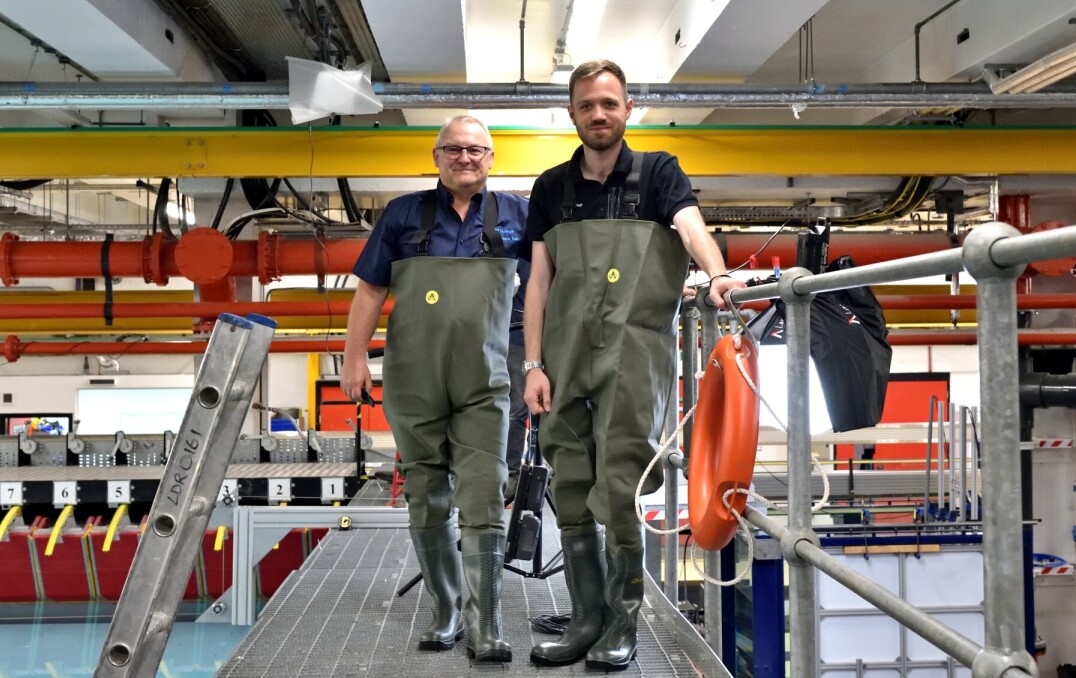
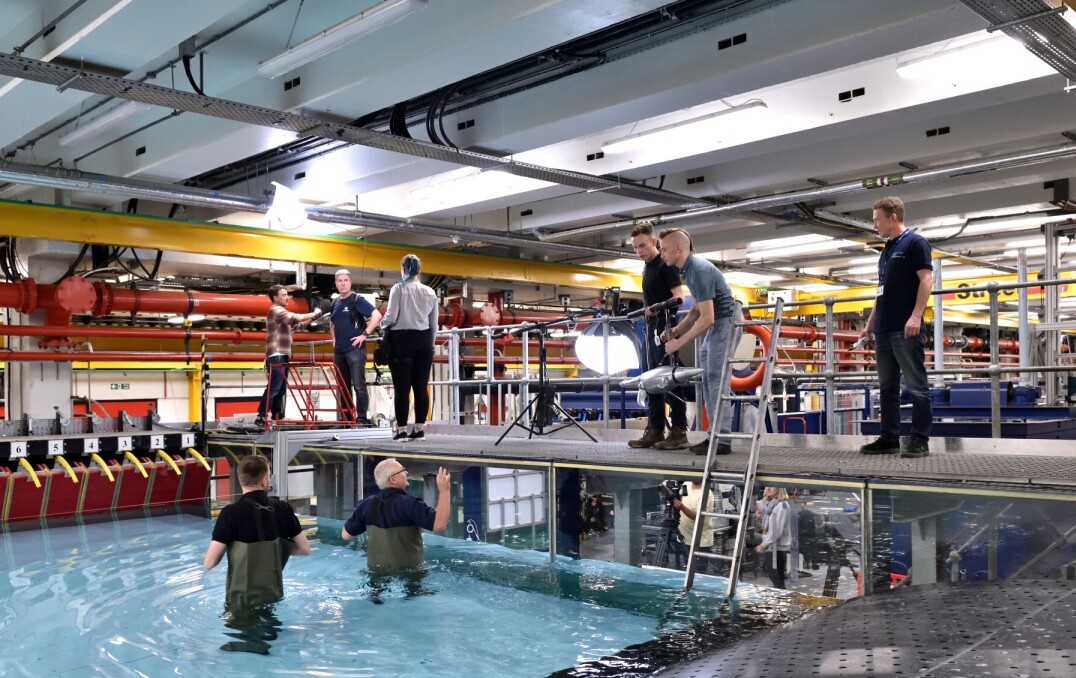
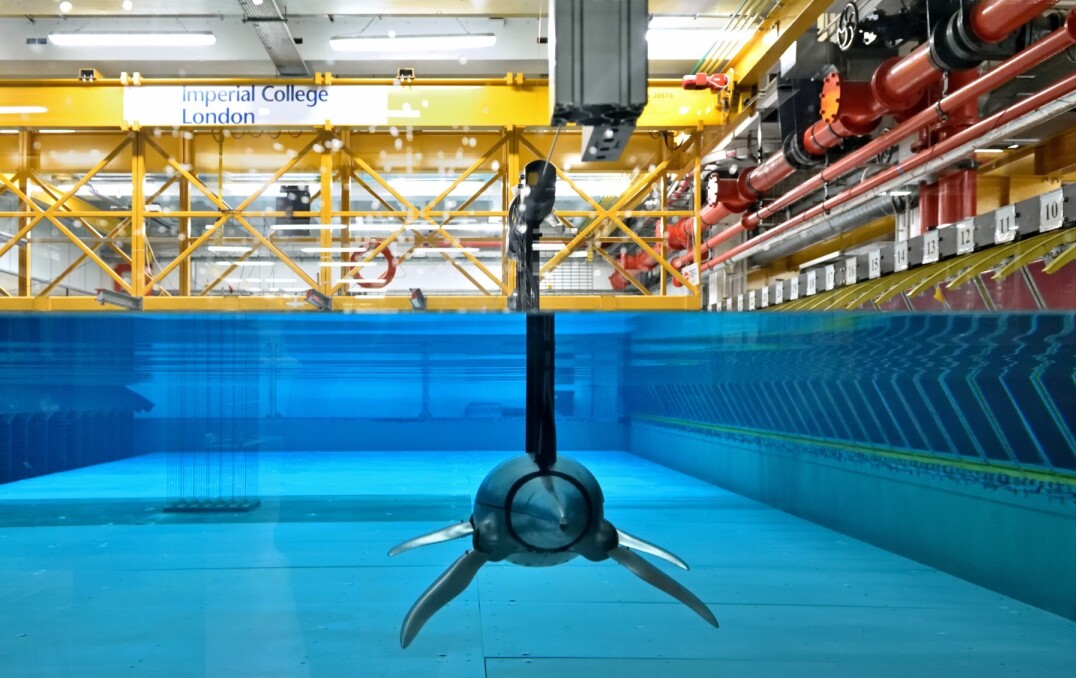
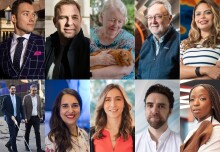


Leave a comment
Your comment may be published, displaying your name as you provide it, unless you request otherwise. Your contact details will never be published.